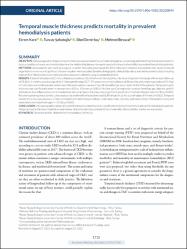| dc.contributor.author | Kara, Ekrem | |
| dc.contributor.author | Sahutoğlu, Tuncay | |
| dc.contributor.author | Demirbaş, Sibel | |
| dc.contributor.author | Beyazal, Mehmet | |
| dc.date.accessioned | 2023-01-09T07:49:38Z | |
| dc.date.available | 2023-01-09T07:49:38Z | |
| dc.date.issued | 2022 | en_US |
| dc.identifier.citation | Kara, E., Şahutoğlu, T., Demirbaş, S., & Beyazal, M. (2022). Temporal muscle thickness predicts mortality in prevalent hemodialysis patients. Revista da Associacao Medica Brasileira (1992), 68(12), 1715–1720. https://doi.org/10.1590/1806-9282.20220844 | en_US |
| dc.identifier.issn | 0104-4230 | |
| dc.identifier.uri | https://doi.org/10.1590/1806-9282.20220844 | |
| dc.identifier.uri | https://hdl.handle.net/11436/7368 | |
| dc.description.abstract | OBJECTIVE: Ultrasonographic temporal muscle thickness measurement has recently emerged as a promising method of nutritional assessment in various conditions; hence, we aimed to determine the relationship between temporal muscle thickness and mortality in prevalent hemodialysis patients. METHODS: Adult patients who were on a regular in-center hemodialysis program for ≥3 months were included, and patients with severe nonrenal organ failure or any recent significant disease inception were excluded. Baseline demographic; clinical, laboratory, and anthropometric data, including malnutrition inflammation score; and outcomes data were collected using a standardized form. RESULTS: A total of 60 patients (32 males, diabetes prevalence: 26.6%) who met the eligibility criteria participated in the study, with a mean follow-up of 33.3±11.5 months, a median age of 66.5 (interquartile range 52.7–74) years, time on hemodialysis of 36 months, and a body mass index of 25.9 kg/ m2. Infections and cardiovascular events were the most common causes of overall mortality that occurred in 41.6% of the patients. Temporal muscle thickness was significantly lower in nonsurvivors (8.8 vs. 10.6 mm, p<0.001). Multivariate Cox regression analysis involving age, albumin, spKt/V, and malnutrition inflammation score revealed that temporal muscle thickness was a significant predictor of mortality (hazard ratio=0.740, p=0.035). Receiver operating characteristic curve analysis has shown 68% of sensitivity and 81.8% of specificity for a cutoff value of 9.4 mm (p<0.001). Temporal muscle thickness was weakly or mildly correlated with hemodialysis vintage, body mass index, albumin, and malnutrition inflammation score and moderately correlated with age (r=−0.536, p<0.001). CONCLUSION: Ultrasonographic temporal muscle thickness has been found as a significant predictor of mortality in prevalent hemodialysis patients. Temporal muscle thickness could be a novel marker of nutritional status and predictor of mortality; hence, further studies are warranted. | en_US |
| dc.language.iso | eng | en_US |
| dc.publisher | Associacao Medica Brasileira | en_US |
| dc.rights | info:eu-repo/semantics/openAccess | en_US |
| dc.subject | Hemodialysis | en_US |
| dc.subject | Malnutrition | en_US |
| dc.subject | Mortality | en_US |
| dc.subject | Temporal muscle | en_US |
| dc.title | Temporal muscle thickness predicts mortality in prevalent hemodialysis patients | en_US |
| dc.type | article | en_US |
| dc.contributor.department | RTEÜ, Tıp Fakültesi, Dahili Tıp Bilimleri Bölümü | en_US |
| dc.contributor.institutionauthor | Kara, Ekrem | |
| dc.contributor.institutionauthor | Demirbaş, Sibel | |
| dc.contributor.institutionauthor | Beyazal, Mehmet | |
| dc.identifier.doi | 10.1590/1806-9282.20220844 | en_US |
| dc.identifier.volume | 68 | en_US |
| dc.identifier.issue | 12 | en_US |
| dc.identifier.startpage | 1715 | en_US |
| dc.identifier.endpage | 1720 | en_US |
| dc.relation.journal | Revista da Associacao Medica Brasileira | en_US |
| dc.relation.publicationcategory | Makale - Uluslararası Hakemli Dergi - Kurum Öğretim Elemanı | en_US |


















